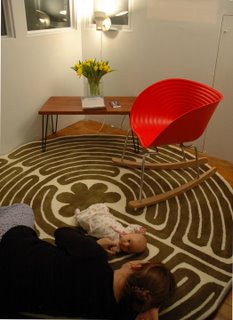
Ennui-ui-ui All The Way Home: The Boring Simplicity of the Montessori Home Environment
Preamble: I said I would talk about something besides crying. Many parents I meet want to know how to bring up a good "Montessori child". To begin, I don't believe that some children are "Montessori children" and some are not. I believe they are all Montessori kids--but you can ease the transition into a Montessori school environment and improve a child's experience if your parenting style is Montessori-compatible. I guess I could start writing about my Montessori parenting experiment anywhere, but I'll start with interior design, just for fun--and because I like it.
For the record, I mean to judge no one's nursery decor. Creating this environment is something of an academic exercise. Call it "Extreme Montessori Decorating"
Designing the Environment:There is a lot of philosophy out there, and many interpretations. Here's my take on designing a Montessori-appropriate home environment, the crux of which is simplicity. It's harder than I had imagined. There are so many cool and beautiful things for our babies that it's hard for a girl to keep her wits about her. I WANT that adorable little egg-shaped bouncer they have at modernseed.com (go check it out, it is so cute!). I want a slick modernist high chair and an heirloom crib tricked out with the dwellbaby crib set. Those things have been marketed successfully to me and I WANT THEM. However, I will not have them because they are not part of the Montessori infant environment and I want to do this all the way.
The following things are omitted by design:
Swings and bouncing contraptions of any kind. We have no bouncy seat, no wind-up swing, no vibrating chair, no exersaucer,and no high chair. The bumbo seat and the bilibo rocker are waiting, gathering dust. There can be nothing to sit on, other than someone's lap, that the baby cannot get into and out of herself, including the chair she eats in. At two months, it's still early for many of those things to be relevant, but the day of reckoning is coming.
Any and all toys that "do" anything. Toys in the Montessori infant environment may not light up, buzz, spin around or move in any way or for any reason that is not visible to the child's eye. My saddest omission in this category is the cute little caterpillar and the bumblebee Lamaze toys--both of which vibrate when you pull the cords. I LOVE these toys. (snif). Rattles must have all the clattering parts on the outside, visible to the child. The Tiffany silver rattle has to stay in its box for now.
The crib. The Montessori mobile infant should be able to get in and out of bed on her own power. Nuvy has a floor bed, which is basically a mattress on the floor, surrounded by a lovely wooden tray, to make it look a little less like a mattress thrown on the floor. Just now she can't move much and she only naps in it, but I'll bet the floor bed thing is about to get very interesting.
Hanging overhead toys. These must be omitted until the baby can get under them or away from them on her own. The Montessori environment may not impose toys on the baby by hanging them in front of her face. She has to choose to play with them. There is a sort of arty, Calder-esque mobile above her bed, but it is high out of her reach, and I consider it an aesthetic element, like paint or a picture on the wall, rather than a toy.
Other environmental design restrictions I'm following:
Separate play and sleep areas. Lucky for me, this is the only practical arrangement in my house. We have two small areas, rather than one big one. There is nothing to play with in her sleep area but a few board books and a "mouthable" book with family photos in it. Later, if she wants it, she can have a "lovey" to sleep with, but I don't mean a menagerie to play with in bed.
Cartoon images. Images of people, animals, or whatever have to be as realistic as possible. I will make certain allowances for stuffed animals, justifying them by not calling them by real animal names. For example, I do not refer to the cutest stuffed horse in the world by saying "This is a horsey!" It isn't. We'll just call it "springy", which it is, and let her figure out that it looks like a horse after she's seen some photos/real horses. Why? So as to preserve the delight she'll get from discovering the likeness herself.
Montessori eyebrow-raisers in my environment:
Mirrors. Mirrors are a subject of hot debate in Montessori infant culture. Those in favor assert that the mirror allows the child to see her own realistic image, and realistic images of other people present. Those opposed say that the mirror image is complicated and confusing--like the rattle with the moving parts inside and out of view--and should be left out as a deceptive element. Personally, I love mirrors, my house is full of them, they brighten and enlarge small spaces of which I have plenty, and I am including them.
Bright colors. Strict adherence to the Montessori infant-environment-design-code requires that all colors be neutral, so as not to overstimulate the new baby, who's got enough to process as it is without the color riot. I have tried to restrain myself, painting the rooms a rather mellow shade of yellow, but I do have a red rocking chair, red cubby storage, and a bright-stripey rug in her bedroom. It's still pretty austere.
The red rocking chair. Strictly speaking, Montessori gurus do not advocate rocking, bouncing or swinging by human hands any more than by mechanical means. It is said to distract the baby from its chosen work (usually screaming its head off, in my experience). After all that discussion about crying and soothing, I've decided that this is hogwash and I will rock my baby in my own arms to soothe her, but I'll try not to rock her all the way to sleep. That's for another post. The rocker gets in by being my contraption, not hers.
Slings and carriers. Same principle. Baby can't control it, baby can't get in and out of the carrier on her own. I object on the same grounds. It's a device to help me use my own body to soothe the baby. Plus, I love wearing her. (Lalala, I can't hear you, Magda Gerber!)
The co-sleeper. It's not exactly co-bedding, but almost, which is not forbidden, but sort of frowned upon. Well, go ahead and frown. When she stops nursing at night and starts rolling over a lot, I'll put her in the floor bed at night.
The Product:
Nuvy's Sleep Room
Nuvy's Play Room
Results so far: So far what seems to happen is that I am humanly responsible for all the forbidden mechanical activities and entertainments, by virtue of my unwillingness to let her cry (Ok, I almost got through the whole thing without talking about crying). I swing, bounce, carry, lull, and make noises and movements for the purpose of her entertainment. Thusly, I have sort of justified the invention of all the conveniences I shun. Of course today, she finally found her thumb, and has spent much of the day in her spare environment, sucking it with relish while gazing at the muted walls or the patterned bandanna she is given to play with. All in all, a pleasant start.




